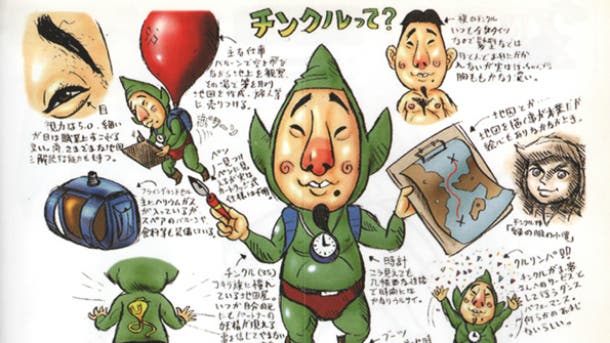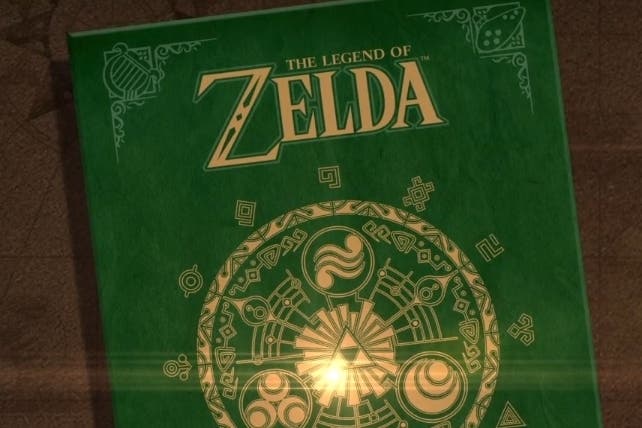The Legend of Zelda: Hyrule Historia review
Link's lavish 25th anniversary art book is unmissable.
For Link's 25th birthday, Nintendo got him a book: a handsome, glossy-papered volume with a Hylian crest embossed on the front in gold foil and a title that should send an electric charge racing through the fingers of anyone who's ever spent a lazy afternoon scudding over the Great Sea or scrabbling up the rusty pathways towards Death Mountain: Hyrule Historia.
Now publisher Dark Horse has brought the Historia to the West, with a full translation - crucially, this includes the designer's scribbled notes that accompany the hundreds of sketches - even nicer paper and a slightly larger form factor. It's genuinely weighty, a plush art book you could use to fend off burglars if you had it to hand at the right moment, yet it walks a delicate line with great care and surprising elegance.
That line, I think, comes down to the way that Nintendo makes games: in secret. It tends not to throw open the doors to the press, clutching their notepads and dictaphones, and it rarely explores the dark creative process with any real openness. This means that there will always be fans who want to know more - who want to pick through the design scribbles and get a peek at various characters, environments, and items that didn't make the final cut. Hyrule Historia's great for all of that sort of thing, as it happens, but, crucially, it never goes too far. It lifts the veil without then flinging it away; you'll learn quite a bit about the Legend of Zelda games by flipping through this book, but you won't escape from the series' essential mystery. Would you want to?

Shigeru Miyamoto's introductory letter sets the tone in this regard. In between neat little snippets of privileged backroom info - the first Zelda was originally conceived as a two-player experience in which friends could construct dungeons and then try them out on each other, for example, while the eponymous princess was named after Scott Fitzgerald's famous, and rather troubled, wife - he announces that he sees himself as the series' guardian, ensuring Link never loses his way as technologies shift and trends evolve, while also, perhaps, saving Hyrule from the kind of overexposure that should have landed Epona on the starting line for a Mario Kart game by now.
What follows is production art - a lot of it, and much of it never seen before - accompanied by a sense that the guardian's presence is never hovering too far away. You won't find a random spread featuring Link's internal skeleton being manipulated on a designer's work station. You won't read about lighting tech or audio occlusion.
The book's divided into quarters, and the first of these tackles Skyward Sword, which would have recently been released when the Historia initially appeared in Japan. It's a bit soon for nostalgia - even considering that this is Zelda we're talking about - but the Wii game's art is delicate and pretty and looks great arranged on the page regardless. Characters, overworlds and dungeons all get a look-in through a mixture of artist's rough sketches and more elaborate renders, and you'll get to learn how the Hylian crest has been influenced by the silhouette of the Loftwing - or is it vice versa by this point? - and pick through different approaches to key characters like Fi, the robotic embodiment of the Goddess Sword.
Early drawings of key areas might just offer a glimpse of the adventure's rather pastelly aesthetic taking shape, but it's the small things that really stick out. A portrait of a student from the game's Knight Academy, for example, is accompanied by a designer's dashed-off note stating that "his most attractive feature is the nape of his neck." It's an observation that feels typically Zelda-esque in its breezy blend of precision and quirk.
After this quick sprint through Skyloft, you'll reach the section that provides the book with its title: a chronology attempting to stitch all of the Zelda games together into a single timeline - albeit a single timeline that splinters in three separate directions after Ocarina.

It's an odd idea, perhaps, but quite a nice one. While it's worth taking any grand designs like this with a pinch of salt, it's still sort of interesting to think of Skyward Sword as providing the very start of the Zelda narrative, or to re-assess Twilight Princess in the context of it being a direct successor to Majora's Mask. As ever, Nintendo's careful to leave tantalising gaps within the framework for future games to explore, and the text stays in character throughout, stressing the mistiness of the current understandings of Link's historical adventures. Was he one boy or many? Why does Ganon keep coming back to cause chaos again and again?
The timeline feels like a playful concession to a certain kind of fan, but it's still nice to have something like this to look over - if only for the next time some manner of playground argument erupts regarding whether A Link to the Past fictionally predates the original Zelda. (It does, apparently.) It's very generously handled, too: relative obscurities like The Minish Cap and Four Swords get six gloriously illustrated pages between them, for example, and as you trace your ancient adventures through the middle of the book, the art that passes by in front of your eyes allows you to track the shifting face of a series that sometimes seems incapable of change.
The third section of the Historia is the star, however: a game-by-game trawl through the archives pulling out all manner of sketches and paintings and even the odd design document. This chapter's full of fascinating stuff, from the revelation that Link became left-handed early on in the development of the first game so that his pixel sprite worked better, to a shot of Tingle without his famous green hood - accompanied by the observation that his hairstyle suggests it was cut by his grandmother. Text is kept to the occasional paragraph, and some of the reproductions are rather small, but these are pages worth hunting through all the same. A drawing of a young Link stoically scowling at a campfire while a huge white moon floats overhead captures the ruminative childlike drama of the series more evocatively than a million essays or double-page spreads, while enemy set lists and grid-based dungeon designs by Miyamoto himself are engrossing, in part, because we get to see this sort of thing so rarely.
If it's a chance to move in close, it's also an opportunity to pull back a little, too. Seeing The Wind Waker, in particular, in the context of the other Zelda games reveals that, while the little hero's GameCube debut offered a fairly drastic change in aesthetic, it was still an evolutionary one. Link's round-headed incarnation built on elements of the art that already existed, and although there's a clear debt to 1960's anime, the game also works as a cheerful inversion of the pot-bellied, stump-legged Majora's Mask - a very different approach to the adventures of a young Link.

Tellingly, the book dwells longer on The Wind Waker than on any of the games that came before it, perhaps because there are suddenly so many different elements to examine. It's a real treasure haul for fans of the Great Sea, in fact, from loving colour studies of moblins and keese to sketches of unused races: one that's sold, rather excitingly, as "talking pea people", another that seems to be a kind of bristly Cousin Itt confection sporting children who will hide in their parent's bushy locks. Every page holds a surprise. Did you know that there was once an island planned that looked like a partially submerged GameCube? What a book.
Closing things out are a brief manga and a fascinating essay from current series director Eiji Aonuma, who says that making a Zelda game feels like setting out on a trip across a vast ocean without a single sea chart and lacking any real sense of the best direction to take. Packed with lovely things to look at, but still strangely coy regarding certain specifics, the Hyrule Historia is the perfect companion for such a voyage - or rather, for the long wait for Aonuma and his crew to return to port again afterwards. It's a tribute to what's been achieved so far and a reminder that, deep inside Nintendo somewhere, the sketches and notes are still spilling forth and the journey is winding ever onwards.

